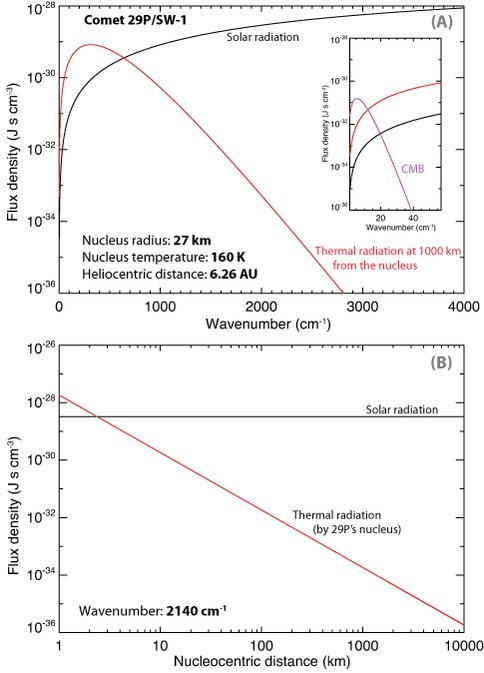2013 Annual Science Report
 NASA Goddard Space Flight Center
Reporting | SEP 2012 – AUG 2013
NASA Goddard Space Flight Center
Reporting | SEP 2012 – AUG 2013
Infrared Detections of Hypervolatiles in Distant Comets - Implications for Chemical Taxonomy
Project Summary
Most IR taxonomic databases of comets concentrate on objects at heliocentric distances within 2 AU, where water (the main volatile species in comets) is active. In 2012, we found that we could quantify hypervolatiles (such as carbon monoxide and methane) using infrared facilities in comets at distances even beyond Jupiter, where water ice cannot sublime efficiently. This project has focused on a new approach to understand the activity of distant comets using infrared facilities, as well as on the role of hypervolatiles in the onset of activity and the implications for current taxonomic databases of primary volatiles.
Project Progress
Most cometary compositions are quantified when they are within 2 AU of the Sun, and are activated by water sublimation. A taxonomy based on the composition of coma gases is emerging, but it is based mainly on comets observed within the water-activated region (< 2 AU from the Sun). This opens the question: is the emergent taxonomy biased by water activation and chemical activity in the surface layer of the nucleus? The question can be addressed by quantifying the coma composition of comets that are still far from the Sun where water ice is not active, but are instead activated by release of hypervolatile gases.
Our program focuses on astronomical observations of comets at very large heliocentric distances where water ice is too cold to sublimate and cometary activity must instead be driven by a more volatile ice, such as CO or CO2. At such distances, since water ice remains immobile owing to low surface temperatures, escaping CO or CO2 will drag icy grains of mixed composition into the coma. Ejection of such mixed grains by sublimation of a hypervolatile matrix will present them to warming in the coma, and the subliming (mixed) material will be less likely to undergo chemical modification. A comparison of the coma composition in such distant comets with that of water-activated comets within 2AU can now inform us on whether chemical alteration has introduced biases to the emerging taxonomic database.
In 2012 we achieved the first IR detection of multiple emission lines of a hyper-volatile species (carbon monoxide) in a comet beyond Jupiter, the Centaur-comet 29P/Schwassmann-Wachmann 1 (Paganini et al. 2013) (Figure 1). The comet was then at a heliocentric distance of 6.26 AU from the Sun, and the rotational temperature of the detected CO was only 5 K. Our IR results established a new record for detections of parent volatiles in comets at relatively large heliocentric distances, and demonstrated new opportunities for targeting volatiles at low rotational temperatures. Our earlier IR detections of CO and trace hypervolatiles (CH4, C2H6) at 3.25 AU, and radio detections (CO, CH3OH, H2CO, HCN, H2S, OH, and CS) at 3.20 AU extend the search strategy substantially (see also the GCA Report by B. P. Bonev).
ALMA will extend the search space even more. It is now possible to quantify the composition of comets in regions where water is not active within the surface layer of the nucleus. Studies of hypervolatile CO have established that the abundance spans a 100-fold range in water–activated comets, from 0.2% in Hartley-2 to 24% in Hale-Bopp. Our advanced infrared strategies now allow the early identification of (the rare) CO-rich comets (Paganini et al. 2012, ApJ, 748, L13). CO ice must have formed in outer regions of the protoplanetary disk after collapse of the nebular cloud, or within irradiated water-organic ice mantles—both shielding CO from the influence of solar radiation. The diverse CO content found in comets, aided by other cosmogonic parameters, has suggested three possible formation scenarios: (1) radial mixing was significant during the formation of icy bodies, (2) some volatiles were selectively shielded in water ice mantles during accretion, and/or (3) cometary nuclei are composed of different structural phases of ice (polar and apolar). New observations are planned for the coming years, and we foresee unique insights into this matter.
Publications
-
Paganini, L., DiSanti, M. A., Mumma, M. J., Villanueva, G. L., Bonev, B. P., Keane, J. V., … Meech, K. J. (2013). THE UNEXPECTEDLY BRIGHT COMET C/2012 F6 (LEMMON) UNVEILED AT NEAR-INFRARED WAVELENGTHS. The Astronomical Journal, 147(1), 15. doi:10.1088/0004-6256/147/1/15
-
Paganini, L., Mumma, M. J., Boehnhardt, H., DiSanti, M. A., Villanueva, G. L., Bonev, B. P., … Blake, G. A. (2013). GROUND-BASED INFRARED DETECTIONS OF CO IN THE CENTAUR-COMET 29P/SCHWASSMANN-WACHMANN 1 AT 6.26 AU FROM THE SUN. The Astrophysical Journal, 766(2), 100. doi:10.1088/0004-637x/766/2/100
-
PROJECT INVESTIGATORS:
-
PROJECT MEMBERS:
Lucas Paganini
Project Investigator
Michael Mumma
Co-Investigator
Geoffrey Blake
Collaborator
Hermann Boehnhardt
Collaborator
Boncho Bonev
Collaborator
Michael DiSanti
Collaborator
Erika Gibb
Collaborator
Jacqueline Keane
Collaborator
Manuela Lippi
Collaborator
Karen Meech
Collaborator
Geronimo Villanueva
Collaborator
-
RELATED OBJECTIVES:
Objective 1.1
Formation and evolution of habitable planets.
Objective 3.1
Sources of prebiotic materials and catalysts
Objective 3.2
Origins and evolution of functional biomolecules
Objective 7.1
Biosignatures to be sought in Solar System materials
